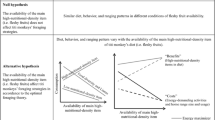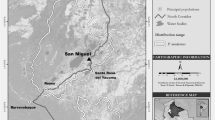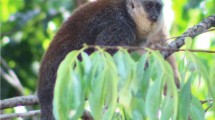Abstract
The behavior and ecology ofAlouatta palliate àre well studied; we report here on the first long-term study of anotherAlouatta species, the red howler monkey,A. seniculus. AlthoughA. seniculus was studied at a high elevation in the Colombian Andes, it exhibits many behavioral and ecological similarities to lowlandA. palliata. Continuous focal sampling indicates thatA. seniculus spends 78.5% of its time resting, 5.6% moving, and 12.7% feeding. It has a day range of 1.09 km and a home range of 22 ha. Like its more northern relative,A. seniculus spends more than 50% of its feeding time on leaves–especially young leaves–but on a dry-weight basis, fruits comprise the majority of its diet. The small home and day ranges observed as well as the large amounts of time spent resting are all argued to be aspects of a relatively folivorous foraging strategy. Daily food intake is estimated to be 1.23 kg fresh weight (0.266 kg dry weight). Foraging efficiency (yield/time) varies by a factor of almost 6 across major food types, with item size and distribution being the key determinants. Food preferences change markedly over the activity period, with high-energy sources predominating early and high-protein sources late.
Similar content being viewed by others
References
Alexander, R. D., Hoogland, J. L., Noonan, K. M., and Sherman, P. W. (1979). Sexual dimorphisms and breeding systems in pinnipeds, ungulates, primates and humans. In Chagnon, N. A., and Irons, W. (eds.),Evolutionary Biology and Human Social Behavior, Duxbury Press, North Scituate, Mass.
Altmann, J. (1974). Observational study of behavior: Sampling methods.Behavior 49: 227–267.
Altmann, S. A. (1959). Field observations on a howling monkey society.J. Mammal. 40: 317–330.
Amerasinghe, F. P., Van Cuylenberg, B. W. B., and Hladik, C. M. (1971). Comparative histology of the alimentary tract of Ceylon primates in correlation with diet.Ceylon J. Sci. Biol. Sci. 9: 75–87.
Baldwin, J. D., and Baldwin, J. I. (1972). Population density and use of space in howling monkeys (Alouatta villosa) in southwestern Panama.Primates 13: 371–379.
Bauchop, T., and Martucci, R. W. (1968). Ruminant-like digestion of the langur monkey.Science 161: 698–700.
Beck, B. B., and Tuttle, R. (1972). The behavior of grey langurs at a Ceylonese waterhole. In Tuttle, R. (ed.),The Functional and Evolutionary Biology of Primates, Aldine-Atherton, Chicago.
Bernstein, I. S. (1964). A field study of the activities of howler monkeys.Anim. Behav. 12: 92–97.
Bertram, B. (1978). Living in groups: Predators and prey. In Krebs, J. R., and Davies, N. B. (eds.),Behavioral Ecology, Blackwell, Oxford.
Campbell, R. S., and Cassady, J. T. (1954). Moisture and protein in forage on Louisiana forest ranges.J. Range Manage. 7: 41–42.
Carpenter, C. R. (1934). A field study of the behavior and social relations of howling monkeys.Comp. Psychol. Monogr. 10(2): 1–168.
Carpenter, C. R. (1965). The howlers of Barro Colorado Island. In DeVore, I. (ed.),Primate Behavior, Holt, Rinehart and Winston, New York.
Charles-Dominique, P. (1971). éco-éthologie des Prosimiens du Gabon.Rev. Biol. Gabon. 7: 121–228.
Chivers, D. (1969). On the daily behavior and spacing of free-ranging howler monkey groups.Folia Primatol. 10: 48–103.
Chivers, D. (1974). The siamang in Malaya: A field study of a primate in tropical rain forest.Contrib. Primatol. 4: I-IX, 1–335.
Clutton-Brock, T. H. (1974a). Activity patterns of red colobus (Colobus badius tephrosceles).Folia Primatol. 21: 161–187.
Clutton-Brock, T. H. (1974b). Primate social organization and ecology.Nature (Lond.) 250: 539–542.
Clutton-Brock, T. H. (1977). Some aspects of intraspecific variation in feeding and ranging behaviour in primates. In Clutton-Brock, T. H. (ed.),Primate Ecology, Academic Press, London.
Coelho, A. M., Jr., Bramblett, C. A., Quick, L. B., and Bramblett, S. A. (1974). Energy budgets of howler and spider monkeys in Guatemala: A socio-bioenergetic analysis of population density and resource availability. Presented to the American Anthropological Association, Mexico City.
Coelho, A. M., Jr., Bramblett, C. A., Quick, L. B., and Bramblett, S. A. (1976). Resource availability and population density in primates: A socio-bioenergetic analysis of the energy budgets of Guatemalan howler and spider monkeys.Primates 17: 63–80.
Collias, N., and Southwick, C. (1952). A field study of population density and social organization in howling monkeys.Proc. Am. Phil. Soc. 96(2): 143–156.
Daly, M., and Wilson, M. (1978).Sex, Evolution and Behavior, Duxbury Press, North Scituate, Mass.
Dunbar, R. I. M., and Dunbar, E. P. (1974). Ecology and population dynamics ofColobus guereza in Ethiopia.Folia Primatol. 21: 188–208.
Eisenberg, J. F., Muckenhirn, N. A., and Rudran, R. (1972). The relation between ecology and social structure in the primates.Science 176: 863–874.
Emlen, J. M. (1966). The role of time and energy in food preference.Am. Natur. 100: 611–617.
Feeny, P. P. (1970). Seasonal changes in oak leaf tannins and nutrients as a cause of spring feeding by winter moth caterpillars.Ecology 51: 565–580.
Fooden, J. (1964). Stomach contents and gastrointestinal proportions of wild-shot Guianan monkeys.Am. J. Phys. Anthropol. 22: 227–231.
Frame, L. H., Malcolm, J. R., Frame, G. W., and van Lawick, H. (1979). Social organization of African wild dogs (Lycaon pictus) on the Serengeti Plains, Tanzania, 1967–1978.Z. Tierpsychol. 50: 225–249.
French, M. H. (1957). Nutritional value of tropical grasses and fodders.Herb. Abstr. 27: 1–9.
Gaulin, S. J. C. (1977).The Ecology of Alouatta seniculusin Andean Cloud Forest, Ph.D. thesis, Harvard University, Cambridge, Mass.
Gaulin, S. J. C., and Craker, L. E. (1979). Protein in vegetative and reproductive tissues of several neotropical species.J. Agr. Food Chem. 27: 791–795.
Gaulin, S. J. C., and Konner, M. J. (1977). On the natural diet of primates, including humans. In Wurtman, R., and Wurtman, J. (eds.),Nutrition and the Brain, Vol. 1, Raven Press, New York.
Gaulin, S. J. C., Knight, D. H., and Gaulin, C. K. (1980). Local variance inAlouatta group size and food availability on Barro Colorado Island.Biotropica 12: 137–143.
Glander, K. E. (1978). Howling monkey feeding behavior and plant secondary compounds: A study in strategies. In Montgomery, G. G. (ed.),The Ecology of Arboreal Folivores, Smithsonian Institution Press, Washington, D.C.
Glander, K. E. (1980). Reproduction and population growth in free-ranging mantled howling monkeys.Am. J. Phys. Anthropol. 53: 25–36.
Groves, C. P. (1973). Notes on the ecology and behavior of the Angola colobus (Colobus angolensis P. L. Sclater 1860) in N.E. Tanzania.Folia Primatol. 20: 12–26.
Heinrich, B. (1972). Temperature regulation in bumblebees,Bombus vagans: A field study.Science 175: 185–187.
Hernandez-Camacho, J., and Cooper, R. W. (1976). The nonhuman primates of Colombia. In Thorington, R. W., and Heltne, P. G. (eds.),Neotropical Primates: Field Studies and Conservation, National Academy of Sciences, Washington, D.C.
Hill, W. C. O. (1962).Primates: Comparative Anatomy and Taxonomy, Vol. 4, Interscience, New York.
Hladik, A., and Hladik, C. M. (1969). Rapports trophiques entre végétation et Primates dans la foret de Barro Colorado (Panama).Terre Vie 1: 25–117.
Hladik, C. M. (1978). Adaptive strategies of primates in relation to leaf eating. In Montgomery, G. G. (ed.),The Ecology of Arboreal Folivores, Smithsonian Institution Press, Washington D.C.
Hladik, C. M., and Hladik, A. (1972). Disponibilités alimentaires et domaines vitaux des Primates à Ceylon.Terre Vie 26: 149–215.
Hladik, C. M., Hladik, A., Bousset, J., Valdebouze, P., Viroben, G., and Delort-Laval, J. (1971). Le regime alimentaire des primates de l’ile de Barro Colorado (Panama).Folia Primatol. 16: 85–122.
Holdridge, L. (1967).Life Zone Ecology, Tropical Science Center, San Jose, Costa Rica.
Horwich, R. H. (1972). Home range and food habits of the Nilgiri langur,Presbytis johnii. J. Bombay Nat. Hist. Soc. 69: 255–267.
Klein, L. L. (1971).The Ecology and Social Organization of the Spider Monkey, Ateles belzebuth, Ph.D. thesis, University of California, Berkeley.
Kurland, J. A., and Gaulin, S. J. C. (1982). The evolution of male parental investment: Effects of genetic relatedness and feeding ecology on the allocation of reproductive effort. In Taub, D. M. (ed.),Primate Males and Infants, Van Nostrand Rheinhold, New York (in press).
McArthur, R. H., and Pianka, E. R. (1966). On optimal use of a patchy environment.Am. Natur. 100: 603–609.
McAuley, C. E. (1975).Howler Monkey Foraging Patterns, Undergraduate honors thesis, Harvard University, Cambridge, Mass.
Milton, K. (1977).The Foraging Strategy of the Howler Monkey (Alouatta palliata)in the Tropical Forest of Barro Colorado Island, Panama, Ph.D. thesis, New York University, New York.
Milton, K. (1979). Factors influencing leaf choice by howler monkeys: A test of some hypotheses of food selection by generalist herbivores.Am. Natur. 114: 362–378.
Milton, K., and May, M. (1976). Body weight, diet and home range area in primates.Nature (Lond.) 259: 459–462.
Mittermeier, R. A. (1973). Groups activity and population dynamics of the howler monkey on Barro Colorado Island.Primates 14: 1–19.
Mukherjee, R. P., and Saha, S. S. (1974). The golden langurs (Presbytis geei Khajuria, 1956) of Assam.Primates 15: 327–340.
Nagy, K. A., and Milton, K. (1979). Energy metabolism and food consumption by wild howler monkeys (Alouatta palliata).Ecology 60: 475–480.
Napier, J. R., and Napier P. H. (1967).A Handbook of Living Primates, Academic Press, New York.
Neville, M. K. (1972). The population structure of red howler monkeys (Alouatta seniculus) in Trinidad and Venezuela.Folia Primatol. 17: 56–86.
Oates, J. F. (1977). The guereza and its food. In Clutton-Brock, T. H. (ed.),Primate Ecology, Academic Press, London.
Oates, J. F., Waterman, P. G., and Choo, G. M. (1980). Food selection by south Indian leaf-monkeys,Presbytis johnii, in relation to leaf chemistry.Oecologia 45: 45–56.
Ohwaki, K., Hungate, R. E., Lotter, L., Hofmann, R. R., and Maloiy, G. (1974). Stomach fermentation in East African colobus monkeys in their natural state.Appl. Microbiol. 27: 713–723.
Petter, J. J. (1965). The lemurs of Madagascar. In DeVore, I. (ed.),Primate Behavior, Holt, Rinehart and Winston, New York.
Petter, J. J., and Petter, A. (1967). The aye-aye of Madagascar. In Altmann, S. A. (ed.),Social Communication Among Primates, University of Chicago Press, Chicago.
Pope, B. L. (1966). The population characteristics of howler monkeys (Alouatta caraya) in northern Argentina.Am. J. Phys. Anthropol. 24: 351–360.
Pyke, G. H., Pulliam, H. R., and Charnov, E. L. (1977). Optimal foraging: A selective review of theory and tests.Quart. Rev. Biol. 52: 137–154.
Raemakers, J. (1978). Changes through the day in food choice of wild gibbons.Folia Primatol. 30: 194–205.
Raemakers, J. (1979). Ecology of sympatric gibbons.Folia Primatol. 31: 227–245.
Richard, A. (1970). A comparative study of the activity patterns and behavior ofAlouatta villosa andAteles geoffroyi.Folia Primatol. 12: 241–263.
Schoener, T. W. (1971). Theory of feeding strategies.Annu. Rev. Ecol. Syst. 2: 369–404.
Smith, C. C. (1977). Feeding behavior and social organization in howling monkeys. In Clutton-Brock, T. H. (ed.),Primate Ecology, Academic Press, London.
Suzuki, A. (1965). An ecological study of wild Japanese monkeys in snowy areas-focused on their food habits.Primates 6: 31–72.
Tattersall, I. (1976). Group structure and activity rhythm inLemur mongoz (Primates, Lemuriformes) on Anjouan and Moheli Islands, Comoro Archipelago.Anthropol. Pap. Am. Mus. Nat. Hist. 53: 369–380.
Taylor, C. R., Caldwell, S. L., and Rowntree, V. J. (1972). Running up and down hills: Some consequences of size.Science 178: 1096–1097.
Thorington, R. W. (1967). Feeding and activity ofCebus andSaimiri in a Colombian forest. In Starck, D., Schneider, R., and Kuhn, H. J. (eds.),Neue Ergebnisse der Primatologie, Gustav Fischer Verlag, Stuttgart.
Thorington, R. W. (1968). Observations of squirrel monkeys in a Colombian forest. In Rosenblum, L. A., and Cooper, R. W. (eds.),The Squirrel Monkey, Academic Press, New York.
Trivers, R. L. (1972). Parental investment and sexual selection. In Campbell, B. G. (ed.),Sexual Selection and the Descent of Man 1871–1971, Aldine, Chicago.
Wrangham, R. W. (1977). Feeding behaviour of chimpanzees in Gombe National Park, Tanzania. In Clutton-Brock, T. H. (ed.),Primate Ecology, Academic Press, London.
Author information
Authors and Affiliations
Rights and permissions
About this article
Cite this article
Gaulin, S.J.C., Gaulin, C.K. Behavioral ecology ofAlouatta seniculus in Andean cloud forest. Int J Primatol 3, 1–32 (1982). https://doi.org/10.1007/BF02693488
Received:
Revised:
Issue Date:
DOI: https://doi.org/10.1007/BF02693488




